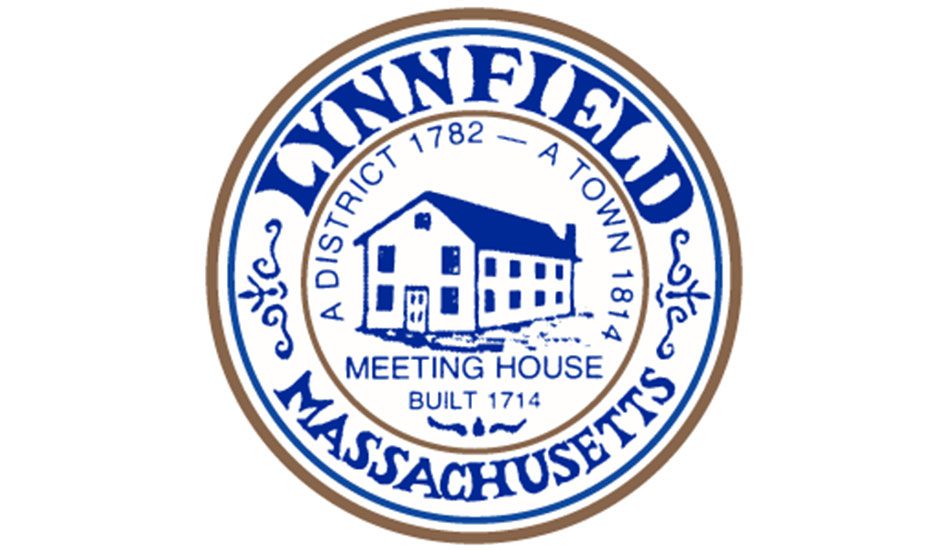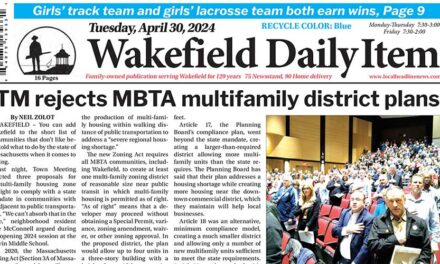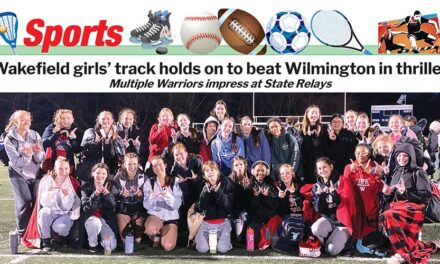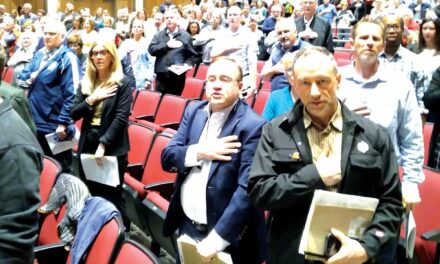By DAN TOMASELLO
LYNNFIELD — The final design for the Wakefield-Lynnfield Rail Trail is scheduled to be completed in 2026, Capital Projects Manager John Scenna said during a recent Select Board meeting.
The rail trail will connect both Lynnfield and Wakefield via the abandoned MBTA rail bed. The Lynnfield section of the rail trail will consist of a 2.8-mile multiuse path and boardwalk that will extend from Fosters Lane in Wakefield, go through Lynnfield and will end at Nichols Lane in Peabody. The Wakefield section will extend an additional 1.6 miles from Fosters Lane to the Galvin Middle School. A portion of the rail trail will go through Reedy Meadow via an elevated boardwalk.
Scenna recalled that the town hired the engineering firm Stantec to design the Lynnfield portion of the rail trail in the fall of 2022. Lynnfield and Wakefield were previously using WorldTech Engineering, but the communities agreed to separate the project and use two different engineering firms. WorldTech is still working on the Wakefield portion of the trail.
“This originally was a Wakefield-Lynnfield project,” said Scenna. “Lynnfield split from Wakefield and we are now moving forward with our own design. We felt this was in the community’s best interest, and the Massachusetts Department of Transportation (MassDOT) accepted that.”
Stantec Senior Project Manager John Hendrickson said the rail trail project is “back on track” after it got delayed for several years. He noted that MassDOT has assigned the Lynnfield Rail Trail as project number 613163.
“We are in the process of completing the 25 percent design,” said Hendrickson.
Hendrickson anticipates the rail trail’s final design will be completed in 2026. He said the rail trail will be going through an extensive federal, state and local environmental permitting process, which will include the Conservation Commissions from both towns.
“The environmental permitting process will begin when we submit the 75 percent design plans to MassDOT in January 2025,” said Hendrickson.
Hendrickson said the rail trail’s estimated cost has increased from $24.5 million to $36.2 million, which he said will be funded entirely by MassDOT’s State Transportation Improvement Program (STIP).
“That is a large increase,” said Hendrickson. “That is because the cost of construction has been crazy the last few years. The town is currently in the process of trying to get that TIP funding in place.”
Hendrickson said MassDOT will determine when both towns will receive funding for the rail trail.
“MassDOT will determine the TIP year,” said Hendrickson.
Scenna said the Federal Emergency Management Agency (FEMA) updated its flood maps last year, and Reedy Meadow is included in the floodplain.
“That forced the project to take a big step back because we had to figure out how to move forward,” said Scenna.
Stantec Project Engineer Joe Rubino said the boardwalk’s elevation had to be raised to make sure it doesn’t get flooded.
“That gets the entire structure out of the floodplain elevation,” said Rubino.
Rubino said the design team recommended that the boardwalk be constructed out of steel and timber.
“The FEMA changes drove our design for the boardwalk,” said Rubino.
Rubino said the boardwalk will include bump-outs and designated areas that will allow people using the rail trail to observe wildlife.
“That is something we are going to look at during future design phases,” said Rubino.
Rubino said Stantec will be creating “a connection at Turtle Island that will connect either end of the boardwalk.”
“We are planning a small area that could house some seating or some sort of kiosk,” said Rubino. “We will need to coordinate this design with National Heritage because there are rare birds in Reedy Meadow.”
Rubino said the rail trail’s width will be 12-feet.
“We are going to be upgrading all of the roadway crossings by installing signs and pavement markings along both the roadway and the trail to make sure there are safe crossings,” said Rubino.
Rubino said the Summer Street crossing will include a rectangular rapid flashing beacon.
“Summer Street is a busier road than Fosters Lane, so we are trying to make sure it’s safe,” said Rubino. “We are providing a parking pull-off for two cars that will both be marked for handicap access. We are also looking to provide other amenities such as bike racks or a trail kiosk.”
Rubino said the Pillings Pond Road crossing will include new wheelchair ramps on both sides of the street as well as signs and pavement markings.
“The trail ends at Nichols Lane in Peabody,” said Rubino. “The plan previously had it ending at the town line. After we got feedback from MassDOT, the trail was then extended into Peabody to meet at Nichols Lane.”
Rubino said Stantec is looking to connect the rail trail to the athletic complexes at Lynnfield Middle School and Lynnfield High School. He also noted that 37 encroachments have been identified on 21 properties in town that will be abutting the rail trail.
“We are planning to present this information during a meeting with MassDOT to talk through next steps about how they want us to proceed with that process with the town,” said Rubino. “We also identified a protected open space parcel in Wakefield that is owned by the Wakefield Conservation Commission. We need to talk with MassDOT about providing right-of-way access through that parcel.”
Scenna thanked Friends of the Lynnfield Rail Trail President Vince Inglese and members Rich Kosian and Ken MacNulty for working collaboratively with the project’s design team.
Select Board Dick Dalton thanked Scenna, Rubino and Hendrickson for giving a thorough presentation about the rail trail project.
“There is a lot of work ahead,” said Dalton.
Select Board member Phil Crawford asked when will the town have to sign the 99-year lease agreement with the MBTA for the rail trail project.
Scenna said Town Counsel Tom Mullen is working with Town Administrator Rob Dolan and Assistant Town Administrator Bob Curtin on the MBTA lease agreement. He noted Mullen also serves as Wakefield’s town counsel.
“We are trying to approach it on parallel paths,” said Scenna.
Select Board Chair Joe Connell said the town has only spent $150,000 on the rail trail project.
“The rest is being paid by the state,” said Connell.
Giugliano Terrace resident Jill Giugliano, who opposes the rail trail, said she wants fencing or screening to be installed on abutting properties.
“I would like a fence or barrier,” said Giugliano. “Please make it part of the design.”
Hendrickson said MassDOT determines whether screening will be installed on abutting properties on a “case-by-case study.”
“From our experience, it’s rare that they do provide screening for abutters,” said Hendrickson.
Giugliano also expressed concerns about potential contamination from the rail bed getting into the environment.
Hendrickson said the rail bed is going to be paved.
“It’s a complete cap,” said Hendrickson. “We are following the Massachusetts Department of Environmental Protection’s guidelines for rail trails.”
In response to a question from Pillings Pond Road resident Kristen Cooper, Dolan said the town currently doesn’t know when it will be receiving STIP funding for the rail trail project.
“Although our rail trail is relatively short compared to other rail trails in the state, it is ranked as a desired project,” said Dolan. “I feel confident, but the tough news is this project as well as every other project has skyrocketed in cost. There are going to be tough decisions made at the state level. That is why I have been on the phone continuously advocating for our project. That is going to be an issue because we don’t know what the future holds there. All we can do is keep going on our timeline.”
Hendrickson said MassDOT is “enthusiastic about this project starting up again.”
Todd Lane resident Keith Nobil, who is the Friends of the Lynnfield Rail Trail’s vice president, asked if the boardwalk will be able to accommodate a fire engine if there is a fire in Reedy Meadow.
Hendrickson said the boardwalk will be able to accommodate ambulances and maintenance vehicles, but not fire engines.
“This boardwalk will be made of steel and IPE wood,” said Hendrickson. “IPE wood is a resilient hard wood. In theory, it will take a lot to burn it down. It’s almost fireproof, which is one of the reasons why it is so expensive.”
Friends of Lynnfield Rail Trail President Vince Inglese emailed the Villager a statement about the project.
“We await clarification on the State Transportation Improvement Program (STIP) funding for construction,” stated Inglese. “The community wants the Lynnfield Rail Trail completed without needless delay. The Friends of the Lynnfield Rail Trail is advocating for the town to provide project transparency and monthly public updates to help improve results. We thank the Select Board for the Stantec/town staff presentation, and look forward to the continued focus and support by the Select Board.”





